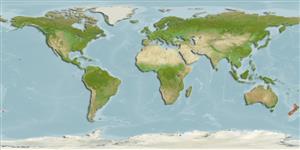>
Eupercaria/misc (Various families in series Eupercaria) >
Labridae (Wrasses)
Etymology: Pseudolabrus: Greek, pseudes = false + Greek, labrax = a fish, Dicentrarchus labrax (Ref. 45335); miles: Specific epithet 'miles' is from the Latin word soldier; referring to the scarlet body color resembling 19th century soldier's uniforms.
More on authors: Schneider & Forster.
Environment: milieu / climate zone / depth range / distribution range
Ecología
marino asociado a arrecife; rango de profundidad 4 - 40 m (Ref. 26203), usually 10 - 40 m (Ref. 26203). Temperate
Distribución
Países | Áreas FAO | Ecosistemas | Ocurrencias, apariciones | Point map | Introducciones | Faunafri
Southwest Pacific: known only from New Zealand including the Snares Islands, Stewart Island, Clatham Islands, and the Three Kings Islands.
Tamaño / Peso / Age
Maturity: Lm ? range ? - ? cm
Max length : 27.2 cm SL macho / no sexado; (Ref. 26203); 26.9 cm SL (female)
Feeds on small mobile animals, preferably crabs. Searches for food among encrusting organisms and algal holdfasts using the large forward-jutting canine teeth to rake its food from the substratum (Ref. 26966).
Life cycle and mating behavior
Madurez | Reproducción | Puesta | Huevos | Fecundidad | Larva
Oviparous, with distinct pairing during breeding (Ref. 205).
Russell, B.C., 1988. Revision of the labrid fish genus Pseudolabrus and allied genera. Rec. Aust. Mus. (Suppl. 9):1-72. (Ref. 26203)
IUCN Red List Status (Ref. 130435: Version 2024-1)
Threat to humans
Harmless
Human uses
Herramientas
Special reports
Download XML
Fuentes de Internet
Estimates based on models
Preferred temperature (Ref.
123201): 10.8 - 16.6, mean 15 °C (based on 24 cells).
Phylogenetic diversity index (Ref.
82804): PD
50 = 0.5002 [Uniqueness, from 0.5 = low to 2.0 = high].
Bayesian length-weight: a=0.01622 (0.00882 - 0.02983), b=2.98 (2.80 - 3.16), in cm total length, based on LWR estimates for this species & (Sub)family-body (Ref.
93245).
Nivel trófico (Ref.
69278): 3.6 ±0.0 se; based on diet studies.
Resiliencia (Ref.
120179): Medio, población duplicada en un tiempo mínimo de 1.4-4.4 años (Preliminary K or Fecundity.).
Fishing Vulnerability (Ref.
59153): Low vulnerability (23 of 100).
Nutrients (Ref.
124155): Calcium = 18 [8, 32] mg/100g; Iron = 0.197 [0.099, 0.446] mg/100g; Protein = 18.4 [15.6, 20.8] %; Omega3 = 0.288 [0.150, 0.581] g/100g; Selenium = 6.29 [2.77, 14.19] μg/100g; VitaminA = 56.4 [12.0, 359.4] μg/100g; Zinc = 0.597 [0.366, 1.136] mg/100g (wet weight);
